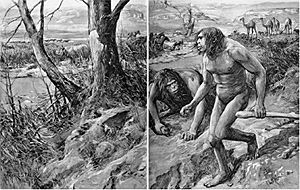Nebraska Man facts for kids

Nebraska Man was the name given to Hesperopithecus haroldcookii, a type of ape. It was thought to be the first ape found in North America. Henry Fairfield Osborn first described it in 1922. This was based on a single tooth found by rancher and geologist Harold Cook in Nebraska in 1917.
Even though Nebraska Man was not a trick, the first idea about what the tooth was turned out to be wrong. Scientists later corrected this mistake in 1927. The name Hesperopithecus means "ape of the western world." The species name haroldcookii was given to honor Harold Cook.
Contents
How the Discovery Happened
In February 1922, Harold Cook wrote to Dr. Henry Osborn about a tooth he had. Cook had found the tooth years earlier in Nebraska. It was found with other fossils common to North America.
Osborn got the tooth in March 1922 and quickly tried to figure out what it was. Osborn and Dr. William D. Matthew thought the tooth belonged to an ape. They then showed the tooth to William K. Gregory and Dr. Milo Hellman. These scientists also agreed it was from an ape, one that seemed more like humans than other apes.
Just a few months later, an article was published in the journal Science. It announced the discovery of a human-like ape in North America. An artist named Amédée Forestier drew a picture of H. haroldcookii. He based the drawing on the "Java Man" (now called Homo erectus). This drawing appeared in the Illustrated London News. Osborn himself did not like the drawing. He called it "a made-up picture with no scientific value."
The Mistake is Corrected
Many scientists were not fully convinced about Hesperopithecus from the start. They kept studying the tooth. The original scientists who described it continued to compare Hesperopithecus to apes.
More digging was done at the site in 1925 and 1926. These new digs uncovered other parts of the skeleton. These new discoveries showed that the tooth was not identified correctly. The tooth did not belong to a human or an ape. Instead, it was from an extinct type of peccary. A peccary is an animal similar to a wild pig. The specific animal was called Prosthennops serus.
The mistake happened because the original tooth was very worn down by weather. This made it hard to identify correctly. The earlier idea that it was an ape was officially taken back in the journal Science in 1927.
Nebraska Man and the Evolution Debate
The idea of H. haroldcookii was not widely accepted by scientists. Also, the species was proven wrong only five years after it was first announced. However, some people who believe in Creationism used this event. They said it showed how scientific errors could make paleontology and human evolution theories seem less believable. They also questioned how such information is reviewed and accepted by scientists.
Around the same time, the teaching of evolution in schools was being debated. This led to the famous Scopes trial. William Jennings Bryan led the side against teaching evolution. Before the trial, Osborn and Bryan argued about their different beliefs. But during the trial, Osborn did not talk about Nebraska Man. Evidence was starting to show that Hesperopithecus was a mistake. Osborn did not want to risk the defense losing the trial.
See also
 In Spanish: Hombre de Nebraska para niños
In Spanish: Hombre de Nebraska para niños


